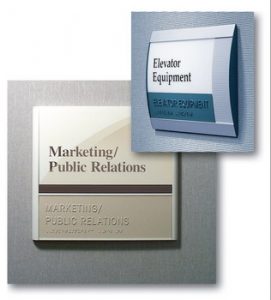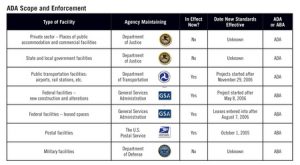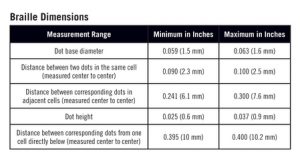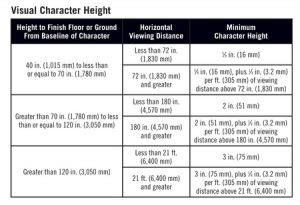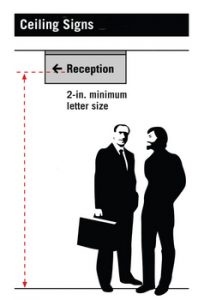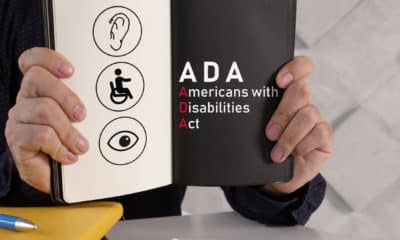ADA Signs
ADA Signage’s New Look and Feel
Final is a relative term; implementation varies.
Published
17 years agoon
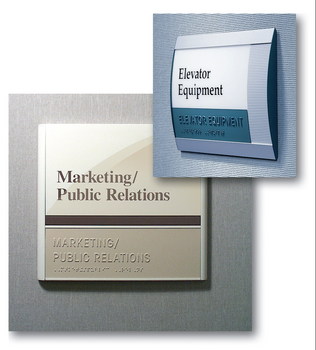
New Americans with Disabilities Act (ADA) guidelines, which define how signs are made for the built environment, have been finalized by the U.S. Access Board. These changes, already in effect for some buildings, carry unknown implementation dates for others. This article will outline the latest rule changes and what they’ll mean to sign-industry and environmental graphic designers, specifically regarding accessible interior signs.
Changes to these signs’ requirements have been anticipated and discussed for years. The U.S. Access Board approved its latest design guidelines for ADA and Architectural Barriers Act (ABA) facilities in July 2004. The new guidelines include extensive changes to the technical requirements for interior architectural signs. Although the original ADA sign section was little more than a page of requirements, the very detailed new section spans more than eight pages.
Although “final,” the new guidelines are not enforceable until they are adopted by the various agencies that maintain them (very similarly to the National Electrical Code). The responsible federal agencies are updating their ABA and ADA standards on separate tracks, and their progress to date varies.
The ADA, which covers the private sector as well as state and local governments, is maintained by the Dept. of Justice (DOJ). The ABA, which covers federally funded facilities, is maintained by several different agencies, including the General Services Administration (GSA), the Dept. of Defense (DOD), the Dept. of Transportation (DOT) and the U.S. Postal Service. The ABA, which replaced the Uniform Federal Accessibility Standards (UFAS), is already in effect for some buildings. Here are some developments:
AdvertisementADA Standards: The ADA sets design requirements for the construction and alteration of places of public accommodation, commercial facilities, and state and local government facilities. The DOJ maintains the ADA standards for these facilities, except for transportation facilities, which are subject to similar standards maintained by the U.S. DOT. Both departments are working to replace the original ADA standards with new ones based on the Access Board’s guidelines.
DOJ: The DOJ is expected to issue another notice and comment period before finalizing adoption of the new standards. This final notice will indicate when the new ADA standards are to be followed. Until that date, the original version of the Americans with Disabilities Act Guidelines (ADAAG) remains in effect. DOJ indicates the process could require two years.
Transportation facilities: ADA standards maintained by the DOT cover public-transportation facilities, including bus stops, rail stations and airports. The DOT adopted the new standards in October 2006.
ABA standards
ABA standards apply to federally funded buildings. However, they don’t pertain to postal, military or residential buildings. GSA adopted new standards based on the Access Board’s updated ABA guidelines on November 8, 2005. The standards apply to construction and alterations that commenced after May 8, 2006 and to leases that began after August 7, 2006.
Postal facilities: The Postal Service issued a notice on May 17, 2005, which adopted new standards for all postal facilities, beginning October 1, 2005.
AdvertisementMilitary facilities: The DOD maintains standards for military facilities and some other facilities. It hasn’t yet indicated when it will adopt the new standards.
Accessible-sign definitions
The new accessibility guidelines include sweeping changes to the sign requirements. The very detailed, new parameters for tactile messages will have far-reaching implications.
Tactile messages. Thin strokes and wide spacing will make it easier to trace letter forms with a finger and make signs more legible for the tactile reader. New guidelines limit a tactile character’s stroke width to 15% of the character’s height, based on an upper-case “I’s” measurements. This restriction, along with sans-serif requirements, dramatically reduces typestyles available for tactile messages.
In addition, character spacing must allow at least 1⁄8 in. between the characters in a word, measured at the reading surface. This minimum can be tricky with smaller letters, because normal kerning would place many character combinations much more closely together. The new guidelines include an exception for beveled characters (i.e., engraving), which allows spacing to be as close as 1/16 in. at the base of the letters.
Visual and tactile
AdvertisementThe new guidelines specifically allow separating visual and tactile characters, either in different areas of the same sign or on two separate signs. Visual signs can utilize many more typographic options, including the use of upper- and lower-case letters, heavier strokes and serif typestyles. With separate visual characters, tactile characters can be as small as ½ in. Many environmental-graphic designers have embraced this concept because it provides a better solution for both tactile and visual readers.
Tactile sign heights
Mounting-height changes are best considered in conjunction with recent changes in the maximum-reach range, which has been lowered to make the built environment more accessible to short-statured people and those who use wheelchairs.
Under the new guidelines, permanent identification signs must be mounted as follows: the tactile characters must be at least 48 in. above the finished floor, measured from the baseline of the lowest tactile characters. Additionally, they can’t be more than 60 in. above the finished floor, measured from the baseline of the highest tactile character.
This essentially lowers the sign height, yet allows some flexibility. The new guidelines will allow a constant top height for interior signs, even when the tactile signs’ heights vary within a system.
The hospitality industry will particularly appreciate a provision that allows tactile signs on doors that close inwardly and don’t have a hold-open device. Examples include hotel-room, fire-exit and restroom signs.
Braille
The new guidelines’ tactile-sign Braille requirements are much more precise, with minimum and maximum dimensions, and Braille must now be positioned beneath the corresponding raised text. If raised text is multi-lined, Braille must be placed below the entire text.
Also, the new guidelines require Braille dots to have a domed or rounded shape in order to allow the widest variety of sign-fabrication methods. “Rounded or domed” is achievable by virtually every process developed for the sign industry.
New rules affect capitalization. Many sign companies simply repeat the tactile, uppercase Braille characters, which makes the Braille all caps, too.
The new ADA is clear: Uppercase letters shall only be used before the first word of sentences, in proper nouns and names, and as individual letters in initials and acronyms.
Visual requirements
The most dramatic change to visual-character requirements is the 5/8-in. minimum character height, with larger characters required for greater viewing distances. For every foot or added viewing distance, add 1/8 in. to the minimum character height.
Many sign professionals will welcome the new, 2-in. minimum cap height for overhead signs, provided that the character's baseline is no higher than 10 ft. above the finished floor. In many situations, space doesn't permit signs to have a 3-in. character height.
Scoping with the ADA
“Scoping” tells building owners where accessible features are required. New guidelines that include two exceptions will make life much easier for those who design, manufacture and purchase interior signs.
Tactile signs will no longer be required in parking facilities. One can safely assume a visually impaired person will be accompanied by a driver in parking decks. Further, tactile signs will no longer be required in non-public areas of prisons. Wayfinding has a different meaning for inmates.
Building codes
Complying with accessibility codes can be complicated. The ADA and ABA are part of the picture. As civil-rights laws, their guidelines are enforced through our justice system. In addition, most states incorporate accessibility language into their building codes, which regularly are subject to change. When the ADA and state codes differ, whichever results in greater accessibility should prevail.
Building codes are constantly evolving. The development process, for the 2008 version of the ANSI A117 Standard on Accessible and Usable Buildings and Facilities, began in July, with several changes proposed to the sign section. The ANSI standard, once finalized, is often included in state building-code updates.
Religious facilities
Were you told that churches, or even church-owned hospitals, are exempt from ADA? Although the ADA doesn’t cover religious facilities, most, if not all, must comply with their local or state building code, and make their buildings accessible. Tactile signs are part of virtually every accessible environment.
More information/resources
The U.S. Access Board maintains an extensive website where you can read about the new guidelines. Go to: www.access-board. gov, then follow the link to New ADA and ABA.
“Scoping” is in Chapter 2, Section 216 Signs, on pages 39 and 40. This section covers the paragraphs of the technical requirements that apply to different types of signs.
For example, signs that identify permanent rooms and spaces must have tactile copy and Braille, while signs that provide directions and information aren’t required to be tactile.
Technical requirements are in Chapter 7, Communication Elements and Features; Section 703 Signs is on pages 223 to 231. This is dense reading that requires careful study.
A list of state-code contacts, with information about accessibility requirements at the state level, is available through this link: www.access-board. gov/links/statecodes.htm.
Spreading the word
These changes to the ADA sign section have been discussed for more than a decade. Recommendations for a new ADAAG were first published by the U.S. Access Board in September 1996. While the initial buzz created by their release has quieted somewhat, the Final Rule nearly replicates what was recommended a decade ago.
Given the dramatic changes to accessible-sign requirements, inevitably, misinformation will circulate through the marketplace. Take time now to understand the new requirements so you can explain them to designers and building professionals you encounter. People want to do the right thing, and understanding signs’ technical requirements is the first step toward willing compliance and enhanced accessibility.
Teresa Cox, president of APCO Graphics Inc. Components Div. (which celebrated its 40th anniversary in August), represents the International Sign Assn. on the ANSI A117 Committee, which develops the Standard on Accessible and Usable Buildings and Facilities.
SPONSORED VIDEO
Introducing the Sign Industry Podcast
The Sign Industry Podcast is a platform for every sign person out there — from the old-timers who bent neon and hand-lettered boats to those venturing into new technologies — we want to get their stories out for everyone to hear. Come join us and listen to stories, learn tricks or techniques, and get insights of what’s to come. We are the world’s second oldest profession. The folks who started the world’s oldest profession needed a sign.
You may like
Advertisement
Subscribe

Magazine
Get the most important news
and business ideas from Signsofthetimes Magazine.
Advertisement
Most Popular
-

 Business Management1 week ago
Business Management1 week agoWhen Should Sign Companies Hire Salespeople or Fire Customers?
-

 Women in Signs1 week ago
Women in Signs1 week ago2024 Women in Signs Award Winners Excel in Diverse Roles
-

 True Tales2 weeks ago
True Tales2 weeks agoSign Company Asked to Train Outside Installers
-

 News2 weeks ago
News2 weeks agoAvery Dennison Wrap Like Royalty Challenge Now Open
-

 Editor's Note5 days ago
Editor's Note5 days agoWhy We Still Need the Women in Signs Award
-

 Maggie Harlow2 weeks ago
Maggie Harlow2 weeks agoThe Surprising Value Complaints Bring to Your Sign Company
-

 Line Time1 week ago
Line Time1 week agoOne Less Thing to Do for Sign Customers
-

 Product Buying + Technology6 days ago
Product Buying + Technology6 days agoADA Signs and More Uses for Engraving Machines

